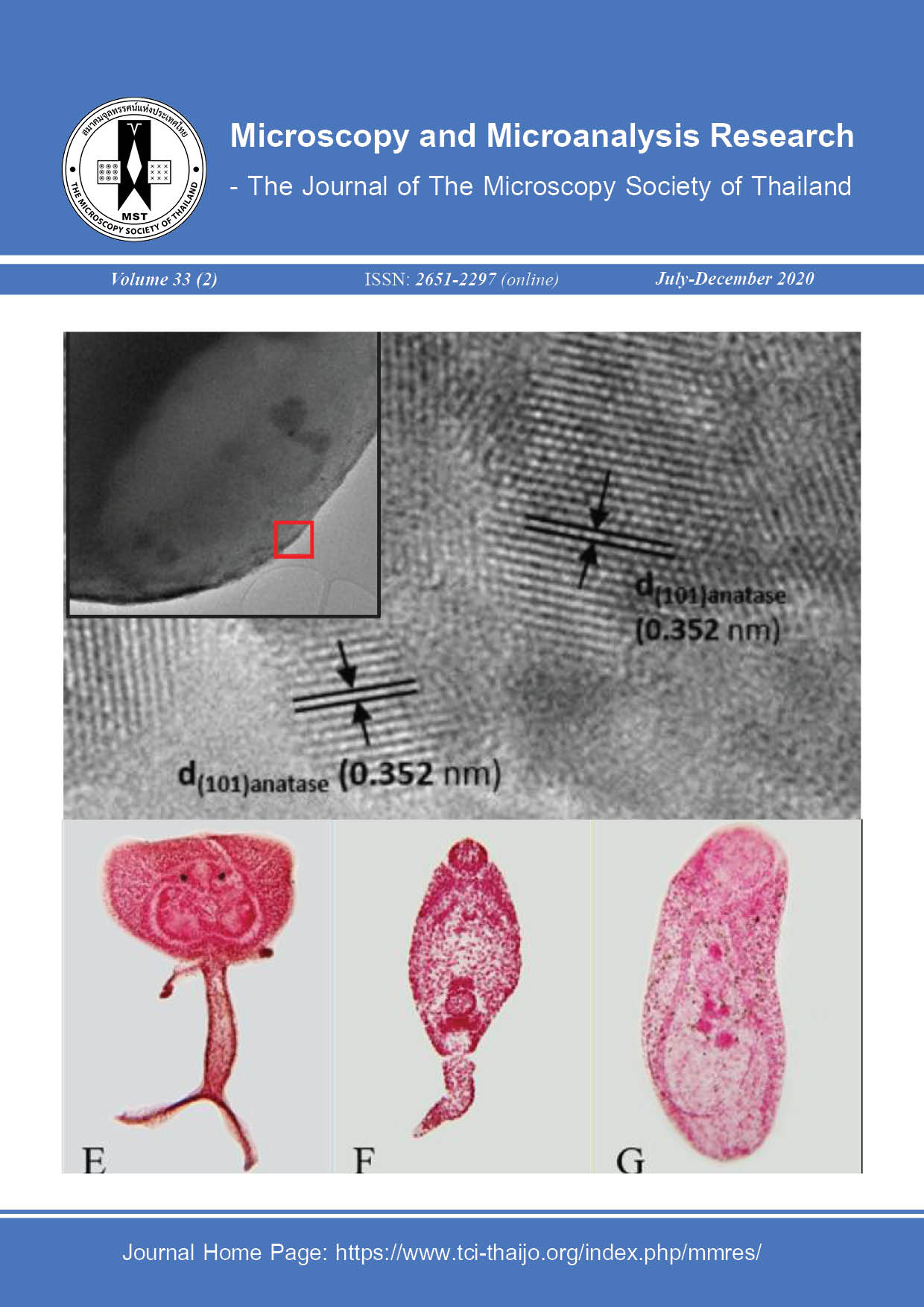Synthesis and Characterization of TiO2 Nanoparticles Deposited on Porous Carbon Material for Dye Removal by Absorption and Photocatalytic Processes
Main Article Content
Abstract
The disappearance of Methyl Orange (MO), Azo dye, in west water was studied using an absorption property from porous carbon and photocatalytic dye degradation using TiO2 nanoparticles. Anatase TiO2 was impregnated on porous carbon by a wet chemical process and post heat treatment at 400oC. The titania precursor concentrations, pH of the chemical solutions, and mixing techniques during the TiO2 impregnation were studied. The MO dye’s degradation using TiO2 on porous carbon after saturated absorption revealed the porous carbon material’s efficiency supported with TiO2 nanoparticles for high photocatalytic activity. The degradation reaction was optimized with the catalyst amount. The impregnated porous carbon samples were characterized using powder X-ray diffraction (XRD), Scanning Electron Microscope (SEM), Transmission Electron Microscope (TEM) and Energy Dispersive Spectroscopy (EDS). The photocatalytic reaction was studied under irradiation of UV light. The XRD, high-resolution transmission electron microscopy (HRTEM) and selected area electron diffraction (SAED) results confirmed that the structure of TiO2 nanoparticles was anatase with high crystallinity and no impurity. The porous carbon substate was amorphous carbon. The average particle diameter of TiO2 nanoparticles measured by SEM and TEM images was 81 nm. Furthermore, the photocatalytic efficiency of as-synthesized samples was 95%, where 100 ml of 5 ppm methyl orange was used as initial concentration with 0.1 g of catalyst dosing for 6 hr under UV irradiation.
Article Details
References
Wang Z., Xue M., Huang K. and Liu Z., Textile Dyeing Wastewater Treatment. In Advances in Treating Textile Effluent, InTech, Shanghai, 2011, pp. 91-116.
Nakata K. and Fujishima A., TiO2 photocatalysis: Design and applications. J. Photochem. Photobiol., C., 13(3): 2012, 169-189.
Fujishima A., Rao T.N. and Tryk D.A., Titanium dioxide photocatalysis. J. Photochem. Photobiol., C., 1(1): 2000, 1-21.
Siyasukh A., Chimupala Y. and Tonanon N., Preparation of magnetic hierarchical porous carbon spheres with graphitic features for high methyl orange adsorption capacity. Carbon, 134: 2018, 207-221.
Fox M.A. and Dulay M.T., Heterogeneous photocatalysis. Chem. Rev., 93(1): 1993, 341-357.
Xu H., Zhang Q., Yan W. , Chu W., A composite Sb-doped SnO2 electrode based on the TiO2 nanotubes prepared by hydrothermal synthesis. Int. J. Electrochem. Sci., 6(12): 2011, 6639–6652.
Liu C., He Y., Wei L., Zhang Y., Zhao Y., Hong J., Chen S., Wang L. and Li J., Hydrothermal Carbon-Coated TiO2 as Support for Co-Based Catalyst in Fischer-Tropsch Synthesis., ACS Catal., 8(2): 2018, 1591–1600.
Pant B., Park M. and Park S., Recent advances in TiO2 films prepared by sol-gel methods for photocatalytic degradation of organic pollutants and antibacterial activities., Coatings, 9(10): 2019, 613.
Chimupala Y., Junploy P., Hardcastle T., Westwood A., Scott A., Johnson B. and Brydson R., Universal synthesis method for mixed-phase TiO2(B)/anatase TiO2 thin films on substrates via a modified low-pressure chemical vapour deposition (LPCVD) route. J. Mater. Chem. A., 4(15): 2016, 5685-5699.


